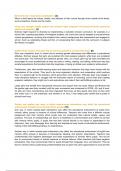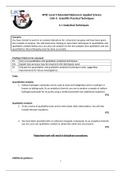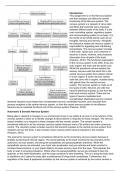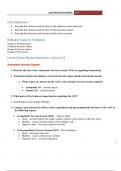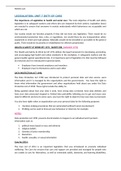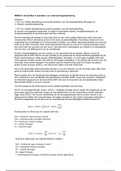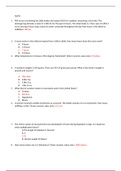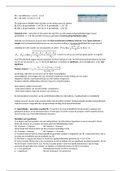[LECTURE STUDY GUIDE] Unit 2
Unit Objectives:
• Describe the structure and function of the skeletal system and joints
• Describe the structure and function of the muscular system
• Describe the structure and function of the nervous system
Relevant Topics in Textbook:
Chapter 7 Skeletal System
Chapter 8 Muscular System
Chapter 9 Nervous System
Chapter 10 The Senses
Lecture Exam Review Questions: Lectures 12 and 13
The Spinal Cord
1. Describe the basic structure (where does it begin and end) and functions of the spinal cord.
• Structure (where does it begin and end):
Begins at Foramen magnum and ends between l1 and l2
• Functions:
o Conduction – bundles of nerve fibers passing information up and down
o Locomotion – nuerons providing control of flexors and extensors
o Reflexes –involuntary, stereotyped responses to stimuli
a. Describe the location and role of the 3 meninges.
• Dura mater – outer most and strongest or toughest collagen
• Arachnoid mater – spiderweb of connective tissue that helps create space for CSF between it
and the pia matter called the subarachnoid space
• Pia mater – delicate layer of connective tissue that is in direct contact with the brain tissue
and spinal cord tissue
b. What is the epidural space? (between what 2 structures?)
• dura matter and periosteum
i. Why might someone receive an epidural?
To reduce pain for childbirth
o
2. What is a nerve?
1
, [LECTURE STUDY GUIDE] Unit 2
• A bundle of neuron axons with connective tissue to strengthen and organize
a. Describe the connective tissue wrappings of a nerve, including the endoneurium,
perineurium and epineurium. Take note of the similarities of this organization, which is
similar to skeletal muscle.
o Endoneurium – connective tissue sheath around each axon
o Perineurium – coarser connective tissue wrapping surrounding fascicles
o Epineurium – tough fibrous sheath around the entire nerve
3. When looking at the spinal cord in cross section, you will notice a dark, gray matter section that
resembles the letter “H”. Be able to identify the dorsal and ventral horns and roots (and the dorsal
root ganglion); describe the type of signal (afferent or efferent) that would be carried within these.
Are they entering or leaving the spinal cord? Where are they coming from or going to?
• Horns
o Ventral – contain cell bodies of motor nuerons
o Dorsal (posterior) – contains cell bodies of sensory internuerons
• Roots
o Ventral – contain motor efferent fibers from motor nuerons in the ventral horn fibers inner age
skeletal muscles, cardiac smooth muscle glands
o Dorsal – contains afferent fibers from sensory nuerons in the dorsal root ganglia conduct
impulses from peripheral receptors
▪ Dorsal root ganglion – collection of neuron cell bodies
4. What types of stimuli can trigger an action potential within the nervous system?
• Temperature, pain, pressure, touch, sounds, chemicals
5. What is a graded potential?
• Sensory receptors specialized to respond to changed in their environment activation results in graded
potentials that can trigger nerve impulses
6. How does the brain (or spinal cord) know what type of signal it is receiving?
2
Unit Objectives:
• Describe the structure and function of the skeletal system and joints
• Describe the structure and function of the muscular system
• Describe the structure and function of the nervous system
Relevant Topics in Textbook:
Chapter 7 Skeletal System
Chapter 8 Muscular System
Chapter 9 Nervous System
Chapter 10 The Senses
Lecture Exam Review Questions: Lectures 12 and 13
The Spinal Cord
1. Describe the basic structure (where does it begin and end) and functions of the spinal cord.
• Structure (where does it begin and end):
Begins at Foramen magnum and ends between l1 and l2
• Functions:
o Conduction – bundles of nerve fibers passing information up and down
o Locomotion – nuerons providing control of flexors and extensors
o Reflexes –involuntary, stereotyped responses to stimuli
a. Describe the location and role of the 3 meninges.
• Dura mater – outer most and strongest or toughest collagen
• Arachnoid mater – spiderweb of connective tissue that helps create space for CSF between it
and the pia matter called the subarachnoid space
• Pia mater – delicate layer of connective tissue that is in direct contact with the brain tissue
and spinal cord tissue
b. What is the epidural space? (between what 2 structures?)
• dura matter and periosteum
i. Why might someone receive an epidural?
To reduce pain for childbirth
o
2. What is a nerve?
1
, [LECTURE STUDY GUIDE] Unit 2
• A bundle of neuron axons with connective tissue to strengthen and organize
a. Describe the connective tissue wrappings of a nerve, including the endoneurium,
perineurium and epineurium. Take note of the similarities of this organization, which is
similar to skeletal muscle.
o Endoneurium – connective tissue sheath around each axon
o Perineurium – coarser connective tissue wrapping surrounding fascicles
o Epineurium – tough fibrous sheath around the entire nerve
3. When looking at the spinal cord in cross section, you will notice a dark, gray matter section that
resembles the letter “H”. Be able to identify the dorsal and ventral horns and roots (and the dorsal
root ganglion); describe the type of signal (afferent or efferent) that would be carried within these.
Are they entering or leaving the spinal cord? Where are they coming from or going to?
• Horns
o Ventral – contain cell bodies of motor nuerons
o Dorsal (posterior) – contains cell bodies of sensory internuerons
• Roots
o Ventral – contain motor efferent fibers from motor nuerons in the ventral horn fibers inner age
skeletal muscles, cardiac smooth muscle glands
o Dorsal – contains afferent fibers from sensory nuerons in the dorsal root ganglia conduct
impulses from peripheral receptors
▪ Dorsal root ganglion – collection of neuron cell bodies
4. What types of stimuli can trigger an action potential within the nervous system?
• Temperature, pain, pressure, touch, sounds, chemicals
5. What is a graded potential?
• Sensory receptors specialized to respond to changed in their environment activation results in graded
potentials that can trigger nerve impulses
6. How does the brain (or spinal cord) know what type of signal it is receiving?
2

